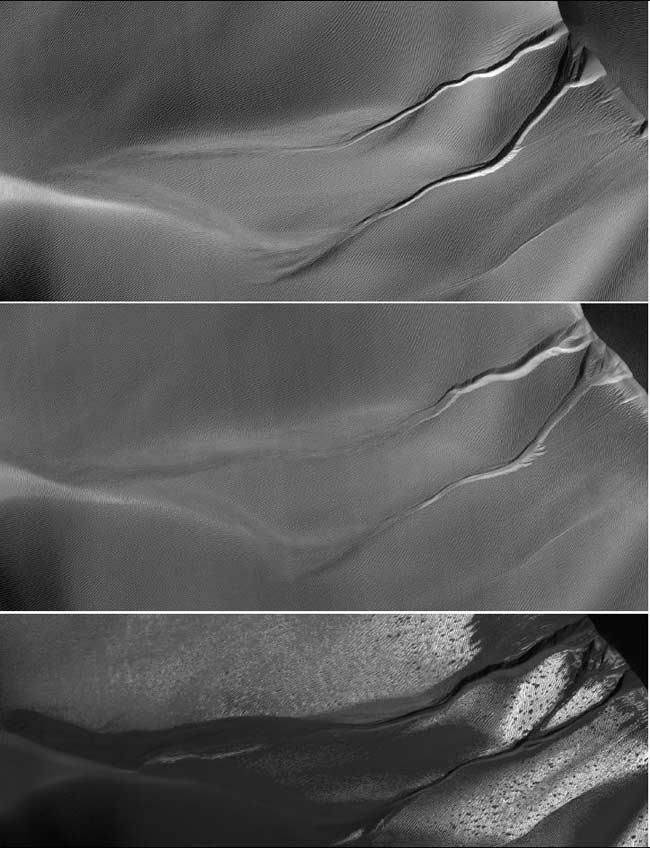Mysterious Mars Gullies Likely Carved By Carbon Dioxide

Some of the mysterious gullies on Mars are likely carved by frozen carbon dioxide, not melting water, a new study finds.
Researchers tracked recent changes in sand dune gullies in seven different locations on southern Mars. They found that these changes — which occurred over the past 15 years or so — popped up most often in winter, which is consistent with the buildup of carbon dioxide frost, not runoff from melting water. [Photos of Martian gullies.]
"Gullies that look like this on Earth are caused by flowing water, but Mars is a different planet with its own mysteries," said study lead author Serina Diniega of NASA's Jet Propulsion Laboratory in Pasadena, Calif. "The timing we see points to carbon dioxide, and if the mechanism is linked to carbon dioxide frost at these dune gullies, the same could be true for other gullies on Mars."
Hunting Mars gullies
Diniega analyzed the gullies while a graduate student at the University of Arizona, before joining NASA at JPL. She and her team studied a set of gullies in southern regions of Mars. The channels range in length from 165 feet (50.3 meters) to more than 2 miles (3.2 km).
The researchers tracked changes in the gullies by comparing photos taken at various times by two different NASA spacecraft: the Mars Global Surveyor, which operated from 1997 to 2006, and the Mars Reconnaissance Orbiter, which has been circling Mars since 2006.
The team spotted changes in 18 different gullies. These alterations occurred primarily in the southern Martian winter, when frozen carbon dioxide would be building up on the dunes.
Photos taken in spring, summer and autumn — times when water could conceivably be melting and running down dune faces — showed no new activity, researchers said.
Get the Space.com Newsletter
Breaking space news, the latest updates on rocket launches, skywatching events and more!
The research is detailed in the November issue of the journal Geology.
Landscape shapers: Water then, carbon dioxide now?
Scientists have suggested various explanations for modern gullies on Mars since they were discovered in 2000. Some of the proposed mechanisms involve water, some carbon dioxide and some neither.
Scientists believe water has covered the surface of Mars at various points in the distant past. Ancient seas, for example, could explain why the planet's northern lowlands hold extensive sedimentary deposits that resemble those seen in the abyssal plains of Earth's ocean floors.
Today, however, the Red Planet is cold and dry. It has deposits of water ice, but scientists haven't confirmed areas with liquid water currently on the surface.
The new results suggest carbon dioxide could be shaping the Martian landscape today — and they call for further study into how this could be happening, researchers said.
"One possibility is that a pile of carbon dioxide frost accumulating on a dune gets thick enough to avalanche down and drag other material with it," Diniegasaid. Other suggested mechanisms are that gas from sublimating frost could lubricate a flow of dry sand or erupt in puffs energetic enough to trigger slides, researchers added.
Join our Space Forums to keep talking space on the latest missions, night sky and more! And if you have a news tip, correction or comment, let us know at: community@space.com.

Space.com is the premier source of space exploration, innovation and astronomy news, chronicling (and celebrating) humanity's ongoing expansion across the final frontier. Originally founded in 1999, Space.com is, and always has been, the passion of writers and editors who are space fans and also trained journalists. Our current news team consists of Editor-in-Chief Tariq Malik; Editor Hanneke Weitering, Senior Space Writer Mike Wall; Senior Writer Meghan Bartels; Senior Writer Chelsea Gohd, Senior Writer Tereza Pultarova and Staff Writer Alexander Cox, focusing on e-commerce. Senior Producer Steve Spaleta oversees our space videos, with Diana Whitcroft as our Social Media Editor.









